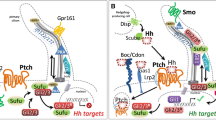Abstract
The vertebrate retina has been widely used as a model to study the development of the central nervous system. Its accessibility and relatively simple organization allow analysis of basic mechanisms such as cell proliferation, differentiation and death. For this reason, it could represent an ideal place to solve the puzzle of Hh signaling during neural development. However, the extensive wealth of data, sometimes apparently discordant, has made the retina one of the most complicated models for studying the role of the Hh cascade. Given the complexity of the field, a deep analysis of the data arising from different animal models is essential. In this review, we will compare and discuss all reported roles of Hh signaling in eye development to shed light on its multiple functions.
Similar content being viewed by others
Author information
Authors and Affiliations
Corresponding author
Additional information
Received 26 September 2003; received after revision 13 November 2003; accepted 19 November 2003
Rights and permissions
About this article
Cite this article
Amato, M.A., Boy, S. & Perron, M. Hedgehog signaling in vertebrate eye development: a growing puzzle. CMLS, Cell. Mol. Life Sci. 61, 899–910 (2004). https://doi.org/10.1007/s00018-003-3370-7
Issue Date:
DOI: https://doi.org/10.1007/s00018-003-3370-7



